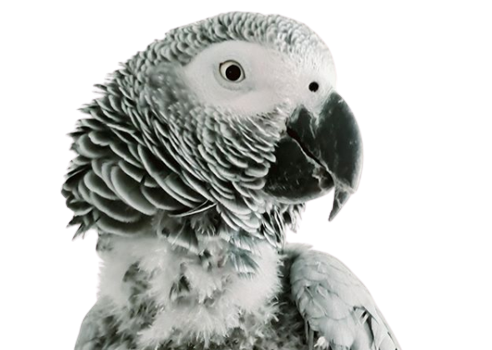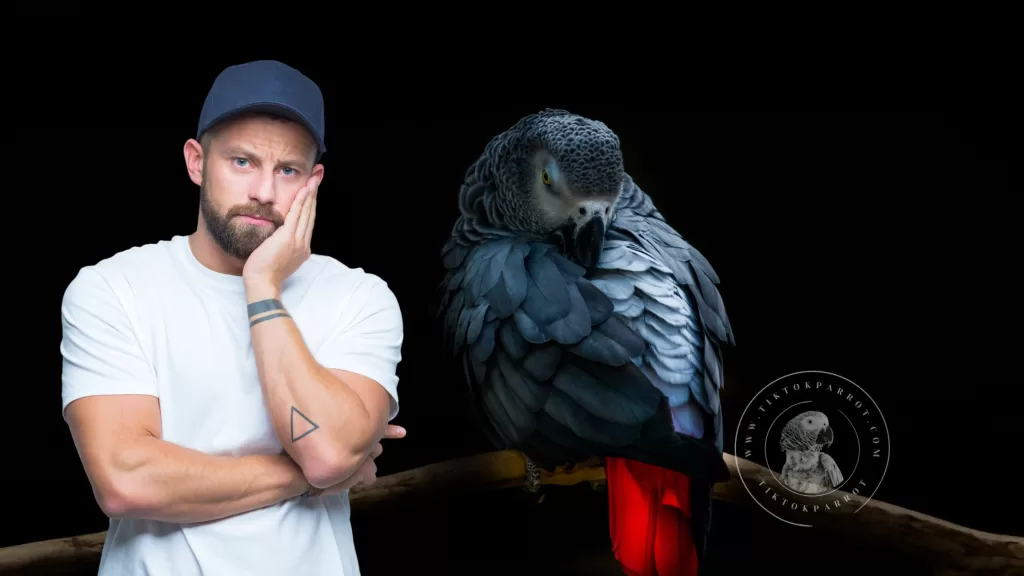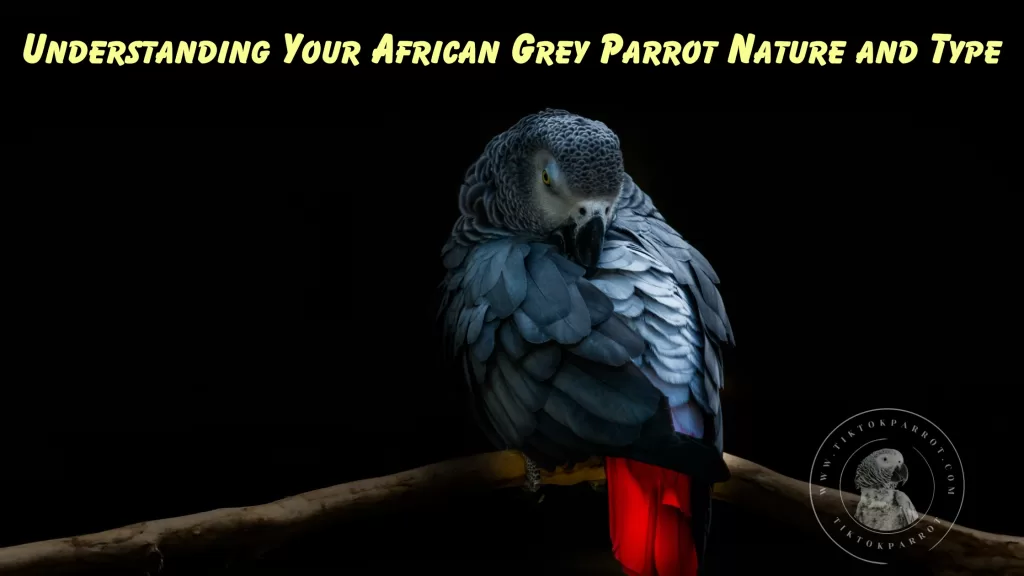African Grey Parrots are highly intelligent birds that inhabit the lush tropical rainforests of West and Central Africa. They are popular birds to keep as pets because they are easy to teach and can copy human sound or speech. Aside from this, African Grey parrots can also mimic other household sounds like the microwave, the dog’s bark and other common everyday sounds.
Unlock the secrets of your African Grey Parrot’s behavior and personality, while learning about their unique traits and needs to help you form a stronger bond with your feathery companion.
African Grey parrots come in several subspecies. The first subspecies is the Congo African Grey parrot. Its scientific name is Psittacus erithacus erithacus. The Congo African Grey is the more popular subspecies preferred by pet owners.
Why? It is because this particular subspecies can reach the size of 33 centimeters or 13 inches. The Congo African Grey parrot has red tails, predominantly light grey feathers, and a beautiful black beak.
The beautiful grey-feathered parrot has a grey iris as a baby but the grey switches to light yellow as it gets older. The Congo African Grey parrot can be found in the forests of the Southern Democratic Republic of Congo, Ivory Coast, Kenya, Northern Angola, Principe, and Bikolo. Sometimes, the Congo African Grey is nicknamed “CAG”.
The second subspecies of African Grey is the Timneh African Grey parrot. Its scientific name is Psittacus erithacus timneh. Compared with the Congo African Grey, the Timneh parrot has a darker shade of grey on its feathers. Its tail is dark red or even maroon in color. Its beak can be two-tone, with the upper beak a shade of beige.
Between the two, the Timneh African Grey parrot is smaller than the Congo African Grey. The TimneH African Grey parrot can be found inhabiting the forests of Sierra Leone, Guinea Bissau, Mali, and Ivory Coast. The Timneh African Grey is also often referred to as “TAG”.
The Congo and the Timneh African Grey subspecies are the two dominant and recognized subspecies of African Grey parrots. However, there are other lesser-known subspecies. One of these is the Ghana African Grey. This type of parrot looks like the Congo African Grey but is generally smaller and darker in color. Its roots are from the Principe Islands of Africa.
Another minor subspecies of African Grey parrot is the Cameroon African Grey. It looks like the Congo African Grey but is slightly larger. Some birds of the Cameroon subspecies also have a darker grey shade on their feathers. This type of parrot inhabits the Democratic Republic of Congo.
All subspecies of African Gray parrots are given the distinction of being high-maintenance. Why? The parrots demand lots of attention from their owners and they need several hours outside their cages each day. Of the two major subspecies, the Congo variety is more cautious around strangers and tends to become closely attached to one caregiver. On the other hand, the Timneh variety is known to start speaking earlier than its Congo cousin.
African Grey parrots also tend to display behavioral problems if they are not stimulated mentally and physically. These behavior problems include biting, plucking their own feathers, and screaming. However, with proper intervention, the behavior problems can go away.
On the whole, African Grey parrots are wonderful pets to keep. However, caution must be taken when there are small kids in the house as the parrots are quite strong and can harm small children with their bites or scratch. Now, let’s delve deeper into the fascinating world of these beautiful birds.
A Journey into the Heart of Your African Grey Parrot
It’s no secret that African Grey parrots are among the most intelligent and captivating birds in the world. But, have you ever wondered what makes them tick?
Understanding your African Grey parrot’s nature and type can help you unlock the door to their complex inner world, making it easier for you to form a deeper bond with your feathered friend. In this article, we’ll explore the various aspects of African Grey parrots, from their distinct types to their intriguing behavior and communication styles. So, let’s dive right in!
African Grey Parrot Types: Timneh vs. Congo
Before we can truly understand your African Grey parrot’s nature and type, it’s important to know that there are two main types of African Greys: the Congo African Grey (CAG) and the Timneh African Grey (TAG). While they’re similar in many ways, there are a few subtle differences that make each type unique:
- Congo African Grey (CAG): The CAG is the larger of the two, with a body length of around 13 inches and a strikingly bright red tail. These birds are native to the rainforests of Central Africa, particularly in countries like Cameroon, Gabon, and the Democratic Republic of Congo.
- Timneh African Grey (TAG): Slightly smaller than the CAG, the TAG measures around 9-11 inches in length and boasts a darker charcoal-gray body with a maroon tail. You’ll find these birds hanging out in the forests of West Africa, including countries like Sierra Leone, Guinea, and Liberia.
Though both subspecies share many similarities, their personalities can differ. Congo Greys are often considered more outgoing and boisterous, while Timneh Greys have a reputation for being more reserved and laid-back. But as with any species, individual personalities may vary.
Chatty Cathy: Communication and Vocalization
African Grey parrots are renowned for their impressive vocal abilities. They can mimic a wide range of sounds, from human speech to everyday noises like doorbells and phone ringtones. In fact, they’re so skilled at mimicking speech that they can even fool you into thinking someone else is in the room!
Understanding your African Grey parrot nature and type also means grasping their unique ways of communicating.
Peeling Back the Layers: The Complex Nature of African Grey Parrots
It’s no secret that African Grey parrots are renowned for their intelligence, but did you know that they’re also deeply emotional creatures? Here are a few key aspects of their nature that set them apart from other parrots:
- Highly Intelligent: African Grey Parrots can learn and understand a vast number of words and phrases, and they’re not just parroting back what they hear – they can actually grasp the meaning of the words they use! No wonder they’re often called “Einsteins with feathers”!
- Emotionally Sensitive: Just like humans, African Greys experience a wide range of emotions, from joy and affection to anxiety and depression. Understanding your African Grey parrot’s nature and type means being attuned to their emotional needs and ensuring that they’re happy and comfortable in their environment.
- Strongly Bonded: African Greys form strong bonds with their human caregivers, and they can become deeply attached to the person who cares for them. This close bond can be both a blessing and a curse, as African Greys may become jealous or possessive of their favorite person.
- Mood Swings: Yup, you read that right! African Grey parrots can have mood swings just like us humans. They can be playful and affectionate one moment and moody and withdrawn the next. It’s important to be patient and understanding with your feathery friend during these times.
Understanding Your African Grey Parrot’s Needs and Preferences
Now that you have a better grasp of your African Grey parrot’s nature and type, let’s delve into their specific needs and preferences:
- Enrichment: African Greys thrive when they have plenty of mental stimulation. Provide them with toys, puzzles, and activities that challenge their intellect and keep them entertained. Boredom can lead to destructive behaviors and emotional issues, so it’s essential to keep your parrot engaged.
- Social Interaction: As social creatures, African Grey parrots need regular interaction with their human caregivers. Schedule daily bonding time with your bird, and consider getting another parrot if you’re not home often to prevent loneliness.
- A Balanced Diet: A proper diet is crucial for your African Grey’s health. Provide them with a mix of high-quality pellets, fresh fruits, vegetables, and nuts. Avoid giving them avocado, chocolate, or caffeine, as these can be toxic to birds.
- A Safe Space: Your African Grey parrot needs a secure, comfortable space to call home. Invest in a high-quality cage that’s large enough for them to move around in, and fill it with perches, toys, and hiding spots.
FAQs
- Can African Grey Parrots talk like humans?
Yes, they can! African Greys are known for their exceptional ability to mimic human speech and can learn and understand a vast number of words and phrases. You can check how my Mitthu used to talk. - How can I encourage my African Grey Parrot to talk?
To encourage your African Grey to talk, engage in regular conversations with them, use positive reinforcement, and be patient as they learn at their own pace. - How do I train my African Grey Parrot to talk?
Use repetition and positive reinforcement to teach your parrot new words and phrases. Be patient and consistent in your training sessions, and remember that each parrot’s learning pace is different. - What is the main difference between Congo African Grey (CAG) and Timneh African Grey (TAG) parrots?
The main difference between the two is their size and coloration. CAGs are larger, with bright red tails, while TAGs are slightly smaller, with maroon tails. - How can I tell if my African Grey Parrot is male or female?
Visual differences between male and female African Greys are subtle. To accurately determine your parrot’s sex, consult an avian veterinarian for a DNA test or surgical sexing. - How can I help my African Grey Parrot adjust to a new home?
Give your parrot time to acclimate to their new surroundings. Provide a consistent routine, offer their favorite foods, and engage in regular, gentle interactions to help them feel comfortable and secure. - What type of toys should I provide my African Grey Parrot for mental stimulation?
Offer a variety of toys, such as puzzle toys, foraging toys, and shred able toys, to keep your parrot engaged and entertained. - How long do African Grey Parrots live?
With proper care, African Grey parrots can live between 40 to 60 years or even up to 80 years if well looked after, so be prepared for a lifelong commitment when bringing one into your home. - Are African Grey Parrots good pets for families with children?
African Greys can make great pets for families with older, more responsible children. However, due to their sensitive nature, they might not be the best choice for families with young or rambunctious children. - Do African Grey Parrots need a companion bird?
While African Greys can bond strongly with their human caregivers, it’s a good idea to consider getting a companion bird if you’re not home often to provide the social interaction they need. - What kind of toys should I provide for my African Grey Parrot?
Offer a variety of toys, including puzzle toys, foraging toys, and chewing toys made from safe materials like wood or natural fibers. Rotate the toys regularly to keep your parrot engaged and interested. - How can I help my African Grey Parrot overcome fear or anxiety?
Provide a consistent routine, a secure environment, and positive reinforcement for desired behaviors. If necessary, consult an avian behaviorist or veterinarian for additional support. - How can I help my African Grey Parrot overcome its fear of new objects or experiences?
Introduce new objects or experiences gradually, using positive reinforcement and treats to help your parrot feel comfortable and confident. Patience and consistency are key when helping your bird overcome its fears. - What are the signs of stress in African Grey Parrots?
Stress in African Greys can manifest through behaviors like feather plucking, aggression, lethargy, or loss of appetite. If you notice any of these signs, consult with an avian veterinarian and evaluate your parrot’s environment to address the underlying cause. - Do African Grey Parrots require regular grooming?
Yes, African Greys need regular grooming, including nail trimming and beak maintenance. Provide a shallow dish of water or a misting bottle for your parrot to bathe in, as regular bathing helps maintain healthy feathers. - Can I train my African Grey Parrot to perform tricks?
Absolutely! African Grey parrots are highly intelligent and can learn a variety of tricks and commands. Use positive reinforcement and treats to encourage your bird to learn new behaviors. - What is the best cage size for an African Grey Parrot?
A minimum cage size for an African Grey should be 36 inches wide, 24 inches deep, and 48 inches tall. However, bigger is always better, and providing your parrot with ample space will help promote their overall well-being. - How do I ensure my African Grey Parrot is getting enough sleep?
African Greys need around 10-12 hours of sleep per night. To ensure proper sleep, cover your parrot’s cage with a light-blocking cover and maintain a consistent sleep schedule. - How can I ensure my African Grey Parrot feels safe in its cage?
Place the cage in a quiet area of your home, away from drafts and direct sunlight. Ensure the cage has adequate space, perches, toys, and hiding spots for your parrot to feel secure. - What type of perch should I provide for my African Grey Parrot?
Provide various types of perches, such as natural wood, rope, or calcium perches, in different sizes and textures to promote foot health and prevent boredom. - What are some common health issues in African Grey Parrots?
African Greys can be prone to health issues like feather plucking, calcium deficiency, and respiratory infections. Regular veterinary check-ups and proper care can help prevent and address these problems. - Do African Grey Parrots need regular veterinary check-ups?
Yes, it’s important to schedule annual check-ups with an avian veterinarian to ensure your parrot’s health and well-being. - What fruits and vegetables can I feed my African Grey Parrot?
Offer a variety of fresh fruits and vegetables, such as apples, berries, carrots, and leafy greens. Always remove seeds and pits from fruits before feeding, as they can be harmful to your parrot. - Can I take my African Grey Parrot outside?
Yes, but only if your parrot is harness-trained or in a secure, parrot-specific carrier. Always monitor your parrot closely and avoid exposing them to extreme temperatures or potential hazards. - How do I know if my African Grey Parrot is healthy?
Signs of a healthy parrot include bright eyes, smooth feathers, regular eating habits, and an active and curious demeanor. If you notice any changes in these signs, consult an avian veterinarian. - How can I prevent my African Grey Parrot from becoming too attached to one person?
Encourage socialization with multiple family members through positive interactions, such as feeding, playtime, and training sessions. This will help prevent your parrot from becoming overly attached to one person.
Embracing Your African Grey’s Unique Nature
Understanding your African Grey parrot’s nature and type is key to forming a strong bond with your feathery companion. By being aware of their intelligence, emotional sensitivity, and unique needs, you can create a loving, supportive environment that allows your African Grey to thrive.
So, go ahead and embrace your parrot’s one-of-a-kind personality, and enjoy the extraordinary journey of getting to know your winged friend!
If you found this blog helpful, It would be great if you could share it with your family and friends who might find it useful as well.
You might like to read these as well.
Types of African Grey Parrots
Tips for Buying an African Grey Parrot
Signs that an African Grey is unhappy with you
Why African Grey Parrots Pluck Feathers
Mental Illnesses in African Greys and How to Spot Them
Why an African Grey Parrot Bites and What to do
What diseases can African Grey parrots get?
What Do You Do If A Parrot’s Beak Breaks?
The Hidden Dangers of a Poor Diet for African Grey Parrots
How to Gain the Love of an African Grey Parrot
The social behavior of African grey parrots in the wild and in captivity
The Hidden Dangers of Owning an African Grey Parrot: What You Need to Watch Out For
Is Your African Grey a Jealous Bird? Here’s What You Need to Know!
African Greys 101: Avoid These Common Mistakes and Keep Your Parrot Thriving!
For more useful content about African grey parrots, you can subscribe my site with your email to get notification upon publishing a new blog, the subscribe box you can see on the right side of this page. Also if you get an alert on your web browser while browsing my site, allow it and that will also give you an alert whenever I publish a new blog. 🙂
Stay safe and much love !




